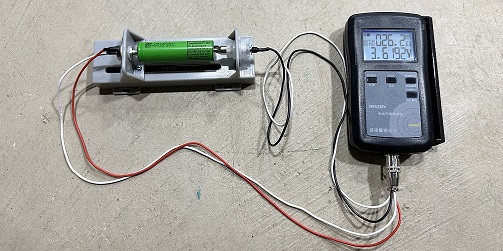
How To Measure Battery IR (Internal Resistance)
Table of Contents
Internal resistance in a lithium-ion battery is a measure of the resistance to the flow of electrical current within the battery. It is caused by factors such as the quality of the electrodes, separator, and electrolyte. Low internal resistance is important for a battery because it allows for efficient transfer of energy, resulting in higher output power and longer battery life. Measuring internal resistance can provide insight into the battery's health, performance, and aging. It is important to monitor internal resistance to detect any performance degradation and predict battery failure, making it a crucial factor in the design, optimization, and maintenance of lithium-ion batteries.
Internal resistance (IR) of a lithium-ion battery can be measured using a variety of different techniques. The most widely used are EIS and DC load testing. EIS, or Electrochemical Impedance Spectroscopy, involves applying a small sinusoidal signal (typically in the MHz range) to the battery and measuring the resulting voltage and current. The ratio of the voltage to the current is known as the impedance, which can be used to calculate the internal resistance of the battery. EIS can be performed using specialized equipment, such as a potentiostat or a frequency response analyzer. This method is widely used in industry and has high accuracy and scientific applications.
The second and much more commonly used method for measuring the internal resistance (IR) of a lithium-ion battery is to apply a load to the battery and measure the voltage drop across the terminals. This method is also known as load testing or DC resistance testing. It is a simple and widely used method for measuring the IR of a battery. In this method, a load is applied to the battery by connecting a resistor across its terminals. The load is typically chosen to be a low-value resistor in order to minimize the impact on the battery. A multimeter is then used to measure the voltage across the terminals of the battery. The IR of the battery can be calculated by dividing the voltage drop across the terminals by the load current.
In this article, we will explain what IR (Internal Resistance) is. We will also go over how to test for it and what the normal range of IR is for healthy battery cells.
What is IR (Internal Resistance)?
Internal resistance (IR) is an important characteristic of a lithium-ion battery because it can greatly affect the performance of the battery. The IR of a battery represents the resistance to the flow of current within the battery, and as such, it can have a significant impact on the battery's ability to deliver power.
High internal resistance can lead to a number of issues including:
- Voltage drop: As a load is applied to the battery, the voltage across the terminals will drop, which can lead to a reduction in the available power.
- Reduced efficiency: High IR can lead to a reduction in the overall efficiency of the battery, as more energy is lost as heat rather than being delivered to the load.
- Reduced capacity: High IR can lead to a reduction in the capacity of the battery, as the voltage across the terminals will drop more quickly as the battery is discharged.
- Reduced cycle life: High IR can lead to a reduction in the number of charge/discharge cycles a battery can go through before it needs to be replaced.
Having a low internal resistance is desirable as it leads to better performance and longer battery life. Low internal resistance allows the battery to deliver more power and maintain a higher voltage across the terminals, which leads to better efficiency and capacity. Using IR to pick the optimal cells when building a battery pack can ensure the best performance.
Measuring the internal resistance of a lithium-ion battery is important to ensure that the battery is in good condition and to ensure that it will perform as expected. It is also important for battery management systems to monitor the internal resistance of the batteries they are managing to detect any issues and take corrective action to mitigate them.
How To Measure Battery IR Step By Step
Step 1: Connect the resistor: Connect the resistor across the terminals of the battery by connecting the positive lead of the resistor to the positive terminal of the battery and the negative lead of the resistor to the negative terminal of the battery. Use the formula below to determine what resistor to use.

Step 3: Calculate IR: Divide the voltage drop across the terminals by the load current. The load current can be calculated by dividing the voltage across the resistor by the value of the resistor.
Step 4: Record the results: Record the IR value you have obtained, as this can be used to compare with other batteries and to monitor the battery's performance over time.
That is it!! Pretty simple to measure IR with a multimeter however for higher accuracy and consistency keep reading onto the next section.
Internal Resistance (IR) Testers
If you want a more simple, more straightforward way to measure IR, you could always use a dedicated IR testing device. Regardless of whether you are doing it manually or using a device that does it for you, it’s important to remember that IR readings will vary depending on how charged the battery is. For this reason, it’s always best to measure IR when the battery or cell is within its nominal voltage range. However, this varies from cell to cell so always consult the cells datasheet.
Using a standalone internal resistance tester will allow you to process more cells in a shorter time span and also provide more accurate and consistent results.
[[ aff type=aff ~ link=https://amzn.to/3JAaOT5 ~ title=`YR1035+ 4 Line IR Tester ` ~ image=https://admin.cellsaviors.com/storage/yr1035 ir tester.jpg ~ description=`` ~ height=small ~ buttonText=`Check Price` ]]
[[ aff type=aff ~ link=https://amzn.to/3HwLhY6 ~ title=`RC3563 IR Tester` ~ image=https://admin.cellsaviors.com/storage/518UzdTF4IL._SX522_.jpg ~ description=`` ~ height=small ~ buttonText=`Check Price` ]]
Drawbacks of Having High IR
High IR, The Silent Disappointer
It's important to know what a high IR is and how it affects performance. As a result of being unaware, a user may never realize that they are not getting the full power of their battery. High IR in a battery causes a voltage drop under load, meaning that the voltage delivered to the load is lower than the voltage of the battery itself.
This results in a reduced amount of power being delivered to the load and the user not getting the full potential power of the battery. If a user is unaware of this phenomenon, they may think that their battery is performing normally, when in fact it is not delivering the full power it is capable of. This can result in the battery not being able to power the device for as long as it should or the device not functioning optimally.
The reduction in power delivered to the load due to high IR can also have a significant impact on the overall life of the device being powered. When the device is not receiving the full power it needs to operate, it is put under more strain and can generate more heat.
High IR, The Keeper Of The Flame
When a voltage drop occurs, it means that some energy is being lost, and this energy has to go somewhere. In electrical systems, energy is often converted into heat, which is why a voltage drop can cause something, somewhere to get hot. This can happen in the battery itself or in other components within the electrical system, such as cables or connectors.
The heat generated by the voltage drop can cause damage to the components, leading to reduced reliability and a shorter lifespan. Furthermore, the heat can also pose a safety risk, as it can cause components to become hot enough to start a fire. This is why it is important to minimize voltage drops in electrical systems to maintain safety, reliability, and performance.
What Is A Good IR For Lithium Ion Cells?
The normal internal resistance (IR) range for lithium-ion cells can vary depending on the type of cell and the manufacturer's specifications. However, in general, the IR of a new and healthy lithium-ion cell should be less than 20 milliohms (mΩ) for small cells (such as those used in mobile devices) and less than 100 mΩ for larger cells (such as those used in electric vehicles). As the cell ages or is used more frequently, the IR may increase.
It's important to note that different types of lithium-ion batteries will have different internal resistance ranges. For example, LiFePO4 batteries, which are known for their high thermal stability, have a lower internal resistance compared to LiCoO2 or LiMn2O4 batteries. Additionally, the internal resistance can vary depending on the temperature, state of charge, and the history of charge-discharge cycles. A new battery will have a lower internal resistance than a used one.
When building a battery pack matching IR of the cells in the pack before assembly can net the battery pack a much longer service life and the BMS will spend less time balancing the battery. Our battery pack repackr allows you to input the IR values of the cells you will be using and balances them for you.
In general, a lower internal resistance value is desirable, as it indicates that the battery will be able to deliver more power and have a longer lifespan. However, it's important to keep in mind that internal resistance is just one of many factors that affect a battery's performance and lifespan. Other factors such as capacity, temperature, and charge-discharge cycles also play a role.
Conclusion
The internal resistance (IR) of a lithium-ion battery plays a critical role in determining the performance and lifespan of the battery. A high IR results in a voltage drop under load, which can lead to reduced efficiency, capacity, and cycle life of the battery. This can also result in the battery not delivering its full potential power to the device, which can put the device under more strain and generate more heat. Measuring the internal resistance of a battery is important to ensure that it is in good condition and to monitor its performance over time.
The two most commonly used methods for measuring IR are EIS (Electrochemical Impedance Spectroscopy) and DC load testing. EIS is a high-precision method used in industry and scientific applications, while DC load testing is a simple and widely used method for measuring IR. DC load testing involves applying a load to the battery and measuring its voltage drop. The voltage drop is used to calculate the battery's internal resistance. This is typically done by applying a constant current load to the battery and measuring the voltage across the battery before and after the load is applied. The internal resistance can then be calculated using Ohm's law (V=IR).
In order to maximize the performance and lifespan of a lithium-ion battery, it is important to monitor its internal resistance and take corrective action when necessary. By understanding the importance of IR and regularly monitoring it, users can ensure that their battery is delivering its full potential power and that the device being powered is operating optimally.
We hope this article answered all the questions you had about how to measure IR, thanks for reading!!


